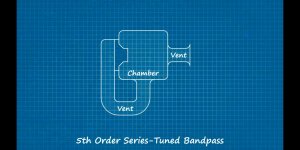I read somewhere where someone built a 3rd-order bandpass box. it looked similar to a normal bandpass, only it had 2 ports, each one of a different size. I wanted to know more about this design, and if anyone else had seen, built, or knows how to build one. anyone know any good sites/resources for odd box (not ported/ passive radiator/ sealed/ 4th or 6th order bandpass)
theChris,
What you say is very interesting. How many cavities and how many ports? And besides the 6.order bandpass with 2 ports and 2 cavities there is another design (not used very much) with no 2. cavitiy but ONLY a second port type (cavitiy) connecting to the first cavitiy (bandpass 5. order?).
For the sake of visual categories here is a video for the different types.
YouTube
What you say is very interesting. How many cavities and how many ports? And besides the 6.order bandpass with 2 ports and 2 cavities there is another design (not used very much) with no 2. cavitiy but ONLY a second port type (cavitiy) connecting to the first cavitiy (bandpass 5. order?).
For the sake of visual categories here is a video for the different types.
YouTube
Attachments
Maybe someone found it already.Maybe Bose copyrighted it after 2001 when this was originally posted
just picking with ya guys
BOSE had indeed different topologies.
theChris,
What you say is very interesting. How many cavities and how many ports? And besides the 6.order bandpass with 2 ports and 2 cavities there is another design (not used very much) with no 2. cavitiy but ONLY a second port type (cavitiy) connecting to the first cavitiy (bandpass 5. order?).
For the sake of visual categories here is a video for the different types.
YouTube
There's no such thing as a "5th order bandpass" either. Well, not unless you include an inductor that's large enough to significantly change the response in the passband.
Look, if that big vent was split in two, and one side was treated as a volume and the other side as the vent for that volume, would it still be a "5th order bandpass" ?
AFAIK there are no odd-order passive designs that involve only a driver and a box.
Wasn't it simply the calculated order from db/oct slope show in sim ?
As a example, I'm actually build a kind of 6th order bandpass (that is how the arrangement is called), that in sim has 4 order high pass and 2nd order low pass. With the same topology, but differents volume settings, it gives a 5th order high pass (30 db/oct), and still a 2nd order low pass. Other arrangement of 6th order bandpass can give differents slopes.
As a example, I'm actually build a kind of 6th order bandpass (that is how the arrangement is called), that in sim has 4 order high pass and 2nd order low pass. With the same topology, but differents volume settings, it gives a 5th order high pass (30 db/oct), and still a 2nd order low pass. Other arrangement of 6th order bandpass can give differents slopes.
- Status
- This old topic is closed. If you want to reopen this topic, contact a moderator using the "Report Post" button.
- Home
- Loudspeakers
- Subwoofers
- 3rd order bandpass designs?
